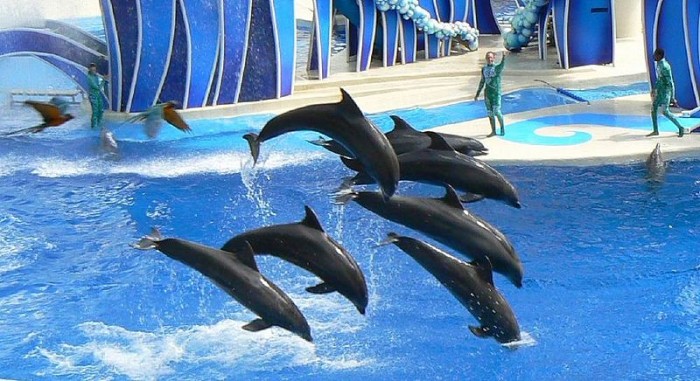
Bottlenose dolphins in captivity
Ah yes, captive breeding of marine mammals. The editors of the Encyclopedia of Marine Mammals decided to have two separate articles about captivity. One on captive breeding, followed by an article on captivity. So in this post, I will just be covering captive breeding. Just wanted to make sure people didn’t think I was intentionally ignoring recent news events. That discussion will come in the next post.
So to breed or not to breed, that is the question. Thankfully, stricter regulations make it much more difficult for marine institutions, like SeaWorld, to just take marine mammals from the wild. This leaves captive breeding as the best alternative to ensuring an ongoing supply of animals. And since it’s very unlikely that this multi-million dollar industry is going to stop making dolphins, killer whales, sea lions and other marine mammals do circus tricks (sigh), it seems better to pursuing captive breeding than rip more animals from their wild homes.
There is much more to captive breeding than meets the eye. According to the Encyclopedia of Marine Mammals: “Professional organizations such as the Association of Zoos and Aquariums (AZA) have established studbooks and other programs to assist with the management of captive animal breeding colonies.” This helps marine institutions throughout the country keep track of who has mated with who to ensure genetic diversity.
Now don’t assume marine mammals are being carted around the country to mate because thanks to technology we have taken all the fun out of marine mammal mating by reducing it to artificial insemination and semen collection. Bottlenose dolphins were the first marine mammals to be successfully trained to provide semen for collection and since then “four killer whales and three Pacific white-sided dolphins and one beluga have been trained to provide semen on a regular basis.”
While male marine mammals are subjected to semen collection, female marine mammals are subjected to tests monitoring hormone surges and ovary activity through ultrasounds. I have to say, after reading about this, I feel even more sorry for the marine mammals in captivity. Talk about being reduced to a science experiment. Is this a necessary evil to prevent more animals from leaving the wild?
Towards the end of the article there is a discussion on how to maintain genetic diversity with a limited number of animals. One suggestion is using assisted reproductive technologies (ART) to collect semen (that haven’t been developed yet) on “wild animals that are incidentally or purposely killed in fisheries or subsistence hunting.” Or another suggestion is the “temporary capture of wild males, followed by semen collection using electro-ejaculation, then release back into the wild after appropriate monitoring.”
Both these options seem wrong on many levels. I really hope ART isn’t used for either, it just doesn’t seem right. But then again we are talking about an issue that has pushed us beyond what is right, which is common when talking about a multi-million dollar industry. If only we could turn back time.
great post as usual!
Marine mammals are food for Japanese, eskimos, norwegians. As long as there is a demand, regardless of the law, businessman, legit or criminal, will fill that demand for the payday. Marine mammal FARMS may be our only hope of putting the whalers out of business for good. By undercutting them on the price “fresh farm raised whale meat, half price!” the whaling industry, and whaling boats could fade into legend. Otherwise, the results, species after species forever lost, is the inevitable result. Prohibition and wars on whaling work about as well as outlawing Capone’s alcohol trade or the drug trade of the cartels. The whales don’t have time for us to continue to not learn that lesson.